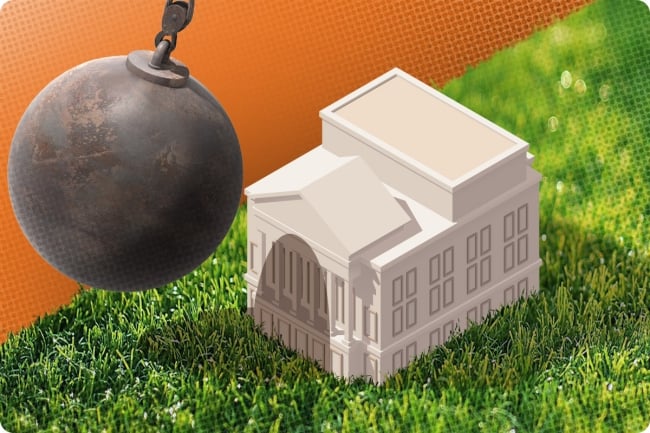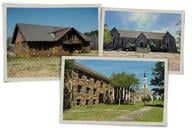You have /5 articles left.
Sign up for a free account or log in.

As some campuses shrink their physical footprint, they’ve emphasized more green spaces.
Photo illustration by Justin Morrison/Inside Higher Ed | ZargonDesign/iStock/Getty Images | Tobi/pexels
As colleges across the nation grapple with declining enrollment, many are simultaneously dealing with aging infrastructure and costly maintenance issues that are often deferred for years.
Some institutions, particularly those battered by enrollment losses, find themselves with more physical space than they need to teach and house a shrinking number of students on campus. And student needs today differ from those of years past, with a more diverse group of learners seeking more connected and collaborative spaces in an increasingly digital environment.
Now, reeling from enrollment losses, some institutions are shedding hundreds of thousands of square feet, knocking down structures to emphasize green spaces and modernize campus facilities for today’s students.
University of Toledo
Since 2010, enrollment has plunged at the University of Toledo, with its head count falling by more than a third over a little more than a decade. While the institution counted more than 23,000 students in 2010, according to federal data, that number stood at 15,013 last fall.
Amid declining enrollment, Toledo has responded by merging colleges and cutting or consolidating dozens of academic programs. It has also shed 1.3 million square feet since 2016, a spatial reduction of 16 percent across campus, according to interim president Matt Schroeder.
Schroeder, who was Toledo’s chief financial officer before he was tapped as interim president earlier this year, emphasized the importance of tying big changes to the university’s mission.
“I think first and foremost, for any institution, you have to answer three simple yet complicated questions: Who are we? What do we do well? And how do we differentiate ourselves?” he said.
With those principles in mind, and emphasizing Toledo’s identity as a public research institution with an academic medical center, Schroeder said, the university shrank its campus mindfully. In doing so, it focused on its academic core and “collegiate gothic architecture,” Schroeder said.
In recent years Toledo has knocked down aging dormitories and academic buildings, creating green spaces to fill those voids, and renovated other structures to bring them up-to-date. The university also sold off a campus that once served as UT’s community and technical college.
And Toledo isn’t done yet. Schroeder said the university plans to shed another 500,000 square feet, which will include razing more buildings, some acquired during a 1990s enrollment boom.
Indiana University of Pennsylvania
Roughly 300 miles away, Indiana University of Pennsylvania is dealing with similar enrollment issues in a state that has been hit hard by demographic challenges, with little reprieve in sight.
In 2010, IUP enrolled 15,126 students, according to federal data. Last fall the university counted 9,254 students. While head count has slipped dramatically since 2010, fall 2023 marked the university’s first enrollment increase in 11 years, climbing by 4.8 percent over fall 2022.
The public university—located in the city of Indiana, Pa.—has brought down multiple buildings in recent years, shedding aging and underutilized facilities and emphasizing green spaces instead. In particular, IUP has focused on highlighting Oak Grove, at the heart of campus.
“It’s a gathering place; it’s really so much of our identity,” said Michelle Fryling, executive director of media relations and communications at IUP, who noted deep alumni connections to what is essentially the university quad, where many graduates met close friends and spouses.
At the same time, IUP has merged or discontinued some academic programs.
“Everything we have done has been focused on our strategic plan,” Fryling said, noting the university has added some new facilities as it demolished multiple aging campus buildings.
Rethinking Campus Spaces
Doug Kozma, a campus planning strategist at the design firm SmithGroup, has helped institutions re-evaluate their physical spaces. As a starting point, he encourages colleges to consider how they are and aren’t using spaces, conducting analysis on space utilization and assessing the conditions of facilities as they consider demolition, renovation or other possible solutions.
“When you put all that together, it offers a snapshot to take things away, to renovate space, to tactically and strategically make the campus better and more nimble for what they’re trying to deliver,” Kozma said.
While enrollment is declining at many institutions across the nation, particularly regional public universities such as IUP and Toledo, today’s students arrive with different expectations and needs. Traditional-age students, and many adult learners as well, are digital natives now.
Kozma suggests that generational change means many no longer want or expect the traditional college classroom in which everything is oriented toward a professor delivering a lecture. Instead there is an appetite for more collaborative, experiential learning spaces. As universities shrink their physical footprint or renovate, Kozma encourages them to rethink traditional classroom design.
Instead of the sloped-floor lecture environment, Kozma said that students, who typically have their own individual devices, are seeking spaces where they can sit in clusters and work together with access to a digital interface to make it easier to share content and collaborate.
Kozma also emphasizes consolidating student services to better serve their needs, such as bringing academic support offices and career counseling under the same roof in one centralized location.
Even as online learning and flexible work diminish the centrality of brick-and-mortar campuses, Kozma says, students and employees still want physical spaces where they can work and learn in a community environment.
“People at the end of the day are still social creatures, and they enjoy being together. I think as we move forward, we don’t want to diminish the importance of the power of place,” Kozma said.
But change at universities is often as unpleasant as it is necessary. Knocking buildings down, even aging units that are now barely inhabitable, can sometimes be met with resistance from faculty members that have spent thousands of hours in familiar offices, or alumni who fondly remember classrooms and dormitories through the nostalgic lens of their student experience.
“We encounter this quite a lot,” Kozma notes. “Memories and traditions matter a great deal.”
Both Fryling and Schroeder acknowledge they’ve faced concerns from students and employees and navigated difficult conversations as the two universities rethought their physical campuses. They both emphasize being thoughtful, transparent and collaborative while making potentially painful changes; universities also need to have a clear vision and the discipline to stick to it.
Schroeder—who is watching financial challenges hitting public institutions like his all across the Midwest—notes the importance of rethinking campuses now before storms arrive in full force.
“I think that the universities like Toledo that can accept the challenges, lean into the opportunities that they create, embrace it and have courage, have discipline, will position these universities in a better light and on a much better foundation for years to come,” he said.




